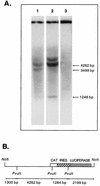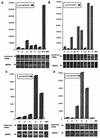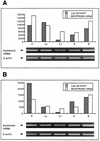Absence of internal ribosome entry site-mediated tissue specificity in the translation of a bicistronic transgene
- PMID: 10074119
- PMCID: PMC104029
- DOI: 10.1128/JVI.73.4.2729-2738.1999
Absence of internal ribosome entry site-mediated tissue specificity in the translation of a bicistronic transgene
Abstract
The 5' noncoding regions of the genomes of picornaviruses form a complex structure that directs cap-independent initiation of translation. This structure has been termed the internal ribosome entry site (IRES). The efficiency of translation initiation was shown, in vitro, to be influenced by the binding of cellular factors to the IRES. Hence, we hypothesized that the IRES might control picornavirus tropism. In order to test this possibility, we made a bicistronic construct in which translation of the luciferase gene is controlled by the IRES of Theiler's murine encephalomyelitis virus. In vitro, we observed that the IRES functions in various cell types and in macrophages, irrespective of their activation state. In vivo, we observed that the IRES is functional in different tissues of transgenic mice. Thus, it seems that the IRES is not an essential determinant of Theiler's virus tropism. On the other hand, the age of the mouse could be critical for IRES function. Indeed, the IRES was found to be more efficient in young mice. Picornavirus IRESs are becoming popular tools in transgenesis technology, since they allow the expression of two genes from the same transcription unit. Our results show that the Theiler's virus IRES is functional in cells of different origins and that it is thus a broad-spectrum tool. The possible age dependency of the IRES function, however, could be a drawback for gene expression in adult mice.
Figures







Similar articles
-
Advances and Breakthroughs in IRES-Directed Translation and Replication of Picornaviruses.mBio. 2023 Apr 25;14(2):e0035823. doi: 10.1128/mbio.00358-23. Epub 2023 Mar 20. mBio. 2023. PMID: 36939331 Free PMC article. Review.
-
Effect of intercistronic length on internal ribosome entry site (IRES) efficiency in bicistronic mRNA.Gene Expr. 1999;8(5-6):299-309. Gene Expr. 1999. PMID: 10947079 Free PMC article.
-
Picornavirus internal ribosome entry site elements can stimulate translation of upstream genes.J Biol Chem. 2007 Jan 5;282(1):132-41. doi: 10.1074/jbc.M608750200. Epub 2006 Nov 8. J Biol Chem. 2007. PMID: 17095505
-
Eukaryotic initiation factor 4G-poly(A) binding protein interaction is required for poly(A) tail-mediated stimulation of picornavirus internal ribosome entry segment-driven translation but not for X-mediated stimulation of hepatitis C virus translation.Mol Cell Biol. 2001 Jul;21(13):4097-109. doi: 10.1128/MCB.21.13.4097-4109.2001. Mol Cell Biol. 2001. PMID: 11390639 Free PMC article.
-
Cap-independent translation of picornavirus RNAs: structure and function of the internal ribosomal entry site.Enzyme. 1990;44(1-4):292-309. doi: 10.1159/000468766. Enzyme. 1990. PMID: 1966843 Review.
Cited by
-
The leader protein of Theiler's virus inhibits immediate-early alpha/beta interferon production.J Virol. 2001 Sep;75(17):7811-7. doi: 10.1128/jvi.75.17.7811-7817.2001. J Virol. 2001. PMID: 11483724 Free PMC article.
-
Non-AUG-initiated internal translation of the L* protein of Theiler's virus and importance of this protein for viral persistence.J Virol. 2002 Nov;76(21):10665-73. doi: 10.1128/jvi.76.21.10665-10673.2002. J Virol. 2002. PMID: 12368308 Free PMC article.
-
IFN-ε is constitutively expressed by cells of the reproductive tract and is inefficiently secreted by fibroblasts and cell lines.PLoS One. 2013 Aug 9;8(8):e71320. doi: 10.1371/journal.pone.0071320. eCollection 2013. PLoS One. 2013. PMID: 23951133 Free PMC article.
-
Influence of the Theiler's virus L* protein on macrophage infection, viral persistence, and neurovirulence.J Virol. 2000 Oct;74(19):9071-7. doi: 10.1128/jvi.74.19.9071-9077.2000. J Virol. 2000. PMID: 10982352 Free PMC article.
-
Bunyamwera bunyavirus nonstructural protein NSs counteracts the induction of alpha/beta interferon.J Virol. 2002 Aug;76(16):7949-55. doi: 10.1128/jvi.76.16.7949-7955.2002. J Virol. 2002. PMID: 12133999 Free PMC article.
References
-
- Agol V I, Grachev V P, Drosdov S G, Kolesnikova M S, Kozlov V G, Ralph N M, Romanova L I, Tolskaya E A, Tyufanov A V, Viktorova E G. Construction and properties of intertypic poliovirus recombinants: first approximation mapping of the major determinants of neurovirulence. Virology. 1984;136:41–55. - PubMed
Publication types
MeSH terms
LinkOut - more resources
Full Text Sources
Miscellaneous

